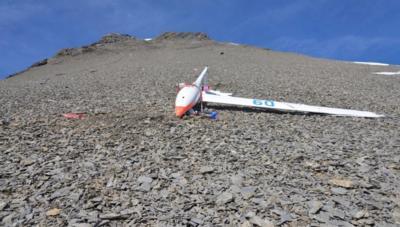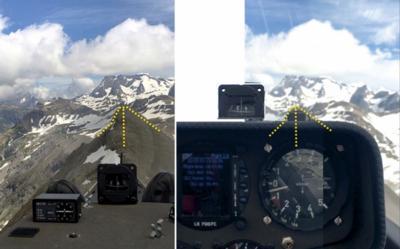Thu, Dec 09, 2021
Pilot Hyperfocused on Filming Mountain, Brought Wing Into Contact With Ridge Face
A Swiss SUST report has been released in regards to a 2016 glider crash wherein a DG-800S glider crashed against the Mittaghore Mountains while on a leisure flight. The report cites the pilot's preoccupation with manipulating his cellular phone to film while flying, resulting in an inadvertent collision between the aircraft's right wing and a nearby mountain ridge.

The Glider was towed into flight from Saanen Airfield on July 6, 2016, where the pilot released the cable to fly along the ridge of Sanetschsee and its pass. Passing through the Arpelistock, the pilot turned towards the nearby mountains with the hopes of approaching the large, imposing summit of Mittaghore for some footage. The glider flew along a ridge, coming within 70 m of the horizontal peak and 110 meters above ground level.
The aircraft passed through a variation of terrain, ultimately maneuvering such a prominently rising portion of Mittaghore was obscured by the instrument panel while filming the interior of the aircraft. The camera was positioned to emphasize the scenic view out the right side, then passed over the pilot's head to capture the widest summit photo possible. The camera panned towards a further mountain as the formerly obscured terrain collided with the right wing of the glider. The aircraft rolled clockwise around its longitudinal and vertial axes. It inverted and impacted the eastern side of Mittaghore and slid downhill for 140 meters, killing the pilot in the process.

The accident occurred on an otherwise fine day for flying, providing another strong warning for the new crop of younger aviators accustomed to filming their activities at all times. Regulations aside, there have been a number of horror stories in most clubs about what can go wrong when flying the plane takes a back seat to getting the perfect shot. From small action cameras broken parts blocking the throttles, to inattentive student pilots rolling inverted while reviewing their camera roll, luck can only cover for so much airborne safety before giving out. For clubs or owners, it may be a helpful risk assessment guide to set standards of minimum filming requirements while in the air, whether they necessitate attachments for hands-off 'set it and forget it' operation, or a second crewmember to handle the in-flight electronics. The report in its entirety can be read in its native German at the Swiss Confederation's SUST website.
More News
Ultrahigh Frequency (UHF) The frequency band between 300 and 3,000 MHz. The bank of radio frequencies used for military air/ground voice communications. In some instances this may >[...]
During The 7 Second Descent, There Was Another TAWS Alert At Which Time The Engine Remained At Full Power On October 24, 2025 at 2115 mountain daylight time, a Cirrus SR22T, N740TS>[...]
From 2009 (YouTube Edition): Educational Organization Aims to Inspire by Sharing Tuskegee Story Founding leader Don Hinz summarized the Red Tail Project’s mission in simple, >[...]
“This feels like an important step since space travel for people with disabilities is still in its very early days... I’m so thankful and hope it inspires a change in m>[...]
Also: New Katanas, Kern County FD Training, IndiGo’s Botched Roster, MGen. Leavitt Named ERAU Dean The Australian Transportation Safety Bureau (ATSB) has wrapped up its inves>[...]
 ANN's Daily Aero-Term (12.19.25): Ultrahigh Frequency (UHF)
ANN's Daily Aero-Term (12.19.25): Ultrahigh Frequency (UHF) NTSB Prelim: Cirrus Design Corp SR22T
NTSB Prelim: Cirrus Design Corp SR22T Classic Aero-TV: The Red Tail Project--Carrying the Torch of the Tuskegee Airmen
Classic Aero-TV: The Red Tail Project--Carrying the Torch of the Tuskegee Airmen Aero-News: Quote of the Day (12.19.25)
Aero-News: Quote of the Day (12.19.25) Airborne 12.17.25: Skydiver Hooks Tail, Cooper Rotax Mount, NTSB v NDAA
Airborne 12.17.25: Skydiver Hooks Tail, Cooper Rotax Mount, NTSB v NDAA




